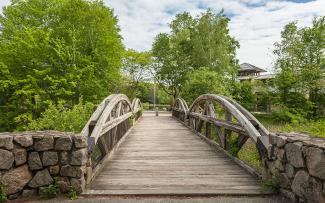Lincoln Woods State Park (1909)

Although an area, known as Quinsnicket pond, and seventy-one acres was purchased in the fall of 1908 for $3,000 from the Stephen H. Smith family of Franklin, Massachusetts, Lincoln Woods State Reservation started officially on Abraham Lincoln’s birthday, February 12, 1909. At a meeting of the Metropolitan Park Commission held at Hearthside, the Commission voted to go ahead with the development of Lincoln Woods. The Hearthside mansion on Great Road, Lincoln, was the original home of Stephen Hopkins Smith, dating from 1810, quite likely the ancestor of the Quinsnicket seller. Between 1908 and 1910, 457.41 acres were purchased to make up the woods and little ponds of Lincoln Woods. By 1918, 458 acres made up Lincoln Woods; most of the land was on the northern side of Olney Pond, which by then boasted a small beach. Over the years since, Lincoln Woods has grown to 627 acres, which now rim the pond and include playing fields to the south. The facilities have grown and improved to include changing rooms for the swimmers, a snack bar, nature barn, and park administrative and maintenance facilities. With bridle and hiking trails throughout, the basic feature besides Olney Pond which also caters to fishing and boating including swimming, is a circumferential road favored by walkers and bicycle riders. In 1977, the swimming area was dedicated as the Frank Moody State Beach.
Until the acquisition of the gift of Goddard Memorial State Park in 1927, Lincoln Woods was the centerpiece of the state park system. It was the largest of the ring of state parks and reservations scattered in a six to eight-mile radius of the center of Providence, connected by spoke-like scenic parkways.
Named after the 16th President of the United States, Lincoln Woods was acquired by purchase, gift, and condemnation of farmland and woodlots of the Olney, Arnold, Comstock, and Mitchell families of the Salyersville, Lonsdale, and Quinsnicket areas of Lincoln. Its northern boundary is modern day Brakeneck Hill and Great Roads and the meandering Moshassuck River.
The funds making the early purchases possible came from an open space bond issue of $250,000 approved by voters in 1906 for use by the relatively new Metropolitan Parks Commission, created in 1904/1905 by the Rhode Island General Assembly. One of the aims of the Park Commission was to carry out the plans for parks inspired by the work of the non-profit, volunteer Public Park Association begun in the 1880’s, who advocated a system of parks in and around Providence that would promote public health and recreation agendas.
A rugged, hilly, tree-lined upland, strewn with giant boulders, the park had been fields with springs along a stream for two centuries before its set-aside as a ‘nature reserve.’ Olney Pond, named after one of the principal families, was more man-made than natural. The Olney’s had impounded the meadow at the eastern end of their property to create a dam offering a fall of water sufficient to run a thread mill about a century earlier than the park development. The Thread Mill Brook leads southeasterly from the dam to other ponds along the Moshassuck, hollowed out for industry as it lopes its way towards Providence. The mill was a three story wooden structure built by George Olney, with a few adjacent two family worker houses and a store.
A second mill, directly on the Mosshassuck, now memorialized only by its name, Manchester Print Works, was on the entrance road to the park, near the park headquarters, very near the new ranger booth and covered bridge. This mill that finished cloth by adding colors and designs was a ‘hard luck’ business, having at different times burned down twice and blown up once due to a defective boiler.
Another legacy of interest was part of the Quinsnicket parcel which began the parade of real estate assembly that fashioned the make up of the park. This was the woodlot developed by industrialist and inventor, Zachariah Allen. In 1820, Allen began an experiment in silviculture, a scientific cultivation of certain trees that would ‘re-forest’ species needed in businesses such as home building, commercial construction, and furniture making. According to some forestry experts, this conscientious effort at inducing tree growth was the first such effort in the country, and it lasted sixty-seven years. Allen kept a diary and ledger.
He was only twenty-five years old when he began the experiment of putting his theory that “vacant land may be profitably improved by planting trees” into practice. At the time this 40 acres was within the bounds of the town of old Smithfield. Lincoln was set off from Smithfield in 1871. Prior to Allen’s tree growing the land, which came into his hands from the division of a relative’s property, had been a worn-out pasture, having been used for that purpose for one hundred years, prior. Because of its exhausted state, and because he had neither the time nor the inclination to devote himself to restoring its lost fertility by the means used normally by agriculturalists of the day, he experimented by turning the entire area into a woodlot. His aim was to receive a profit for this effort down the road. His careful nurturing of the lot and his accounting of its production for more than half a century proved him correct.
Allen was able to indulge himself in this program because he owned the mill villages nearby of Allendale and Georgiaville. He ‘invented’ the Factory Mutual Fire Insurance Company, now known as FM Global, the largest insurer of manufacturing facilities in the world, with its world headquarters in Johnston, Rhode Island.
Over its century of public use, Lincoln Woods provided and continues to provide a scenic background for outdoor recreation in all seasons. Picnic tables with fireplaces, hiking and biking trails, ball fields and horseback riding. The beach and swimming area provides summer relief to thousands of city dwellers from Pawtucket, Central Falls, Woonsocket, and Providence. In the days of crowded triple decker housing, in densely populated industrial districts, the fresh air and woodland scenery of Lincoln Woods was both a destination of healthy change and became a family photo album of happy memories for many. Originally accessible by transportation to the Quinsnicket trolley station on Brakeneck Hill, it is now easily accessible by auto.
For over a century Lincoln Woods administration has been able to find intelligent ways to achieve “proper preservation of the site while affording the greatest good for the greatest number, for the longest time.” Today, the foresight of its original design, influenced by the famous landscape design firm, Olmsted Brothers endures. It boasts two freshwater beaches, 176 picnic tables, 134 fireplaces, toilet facilities, bath house, fishing and boating facilities, ice skating, three game fields, hiking trails, six miles of horse trails, and three miles for snowmobiles.
